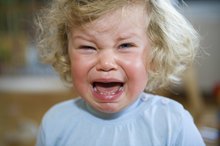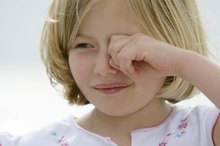Kids Complaining of Clogged Ears and Nose
Nearly all children will experience a clogged nose and ears, also referred to as congestion or stuffy nose. Most of the time, these uncomfortable symptoms result from a minor illness or allergies. Fortunately, your child’s symptoms are easily treatable with home care and medications as needed and preventable with behavioral and lifestyle changes.
If you are experiencing serious medical symptoms, seek emergency treatment immediately.
Symptoms
When your child has a clogged nose and ears, difficulty with sleeping is common due to her discomfort and trouble breathing. Pressure from the congestion in her ears and nose often leads to facial pain, headaches and nasal discharge, along with irritability. If the clogged and congested feeling in your child’s ears and nose persists for a long period of time, these symptoms could cause delays or other problems with her speech development and hearing, according to the National Library of Medicine 1.
- When your child has a clogged nose and ears, difficulty with sleeping is common due to her discomfort and trouble breathing.
- If the clogged and congested feeling in your child’s ears and nose persists for a long period of time, these symptoms could cause delays or other problems with her speech development and hearing, according to the National Library of Medicine 1.
Causes
What to Do for a 2 Year Old's Sinus Congestion
Learn More
Clogged ears and nose in kids usually result from an infection, such as the common cold, a sinus infection or influenza. Congestion from these infections lasts for about one to two weeks. Clogged ears and nose in your child that lasts for more than a few weeks often results from environmental allergies, such as ragweed allergy or from indoor allergies, like pet dander.
- Clogged ears and nose in kids usually result from an infection, such as the common cold, a sinus infection or influenza.
- Clogged ears and nose in your child that lasts for more than a few weeks often results from environmental allergies, such as ragweed allergy or from indoor allergies, like pet dander.
Treatments
If your child is too young to blow her own nose, placing two to three saline drops in each nostril helps to loosen thick mucus that clogs the nose and ears. Make your own saline drops using ¼ tsp. salt mixed into ½ cup lukewarm water, advises the National Library of Medicine 1. Elevating the head of your child’s bed also helps reduce clogging of her nose and ears during the night, and running a cool mist vaporizer helps reduce nasal and ear clogs and reduce inflammation of the nasal and sinus passages. Encourage your kid to drink plenty of fluids, especially warm ones, such as chicken soup or hot cocoa, to help thin the mucus. If she is experiencing pain in her ears or face, children’s acetaminophen as recommended by your pediatrician treats the pain. Check with your pediatrician before giving your child over-the-counter decongestants or antihistamines, as these medications sometimes reduce stuffiness but in some cases actually make the congestion worse.
- If your child is too young to blow her own nose, placing two to three saline drops in each nostril helps to loosen thick mucus that clogs the nose and ears.
Prevention
Night Time Congestion in Children
Learn More
Do not allow people to smoke around your children, as tobacco smoke irritates the respiratory system and increases symptoms of congestion. Teaching children proper hand washing hygiene and coughing and sneezing etiquette helps prevent the spread of illnesses, such as the common cold. Talk to your child’s pediatrician about starting her on an antihistamine medication before her allergy symptoms worsen to the point that she experiences a clogged nose and ears.
Related Articles
References
- National Library of Medicine: Nasal Congestion
- St. Louis Children's Hospital: Sinus Pain and Congestion
- Centers for Disease Control and Prevention. Respiratory syncytial virus (RSV). Updated June 26, 2018.
- Cleveland Clinic. Sinus Infection (Sinusitis). Updated February 10, 2018.
- Dzieciolowska-Baran E, Teul-Swiniarska I, Gawlikowska-Sroka A, Poziomkowska-Gesicka I, Zietek Z. Rhinitis as a cause of respiratory disorders during pregnancy. Adv Exp Med Biol. 2013;755:213-20. doi:10.1007/978-94-007-4546-9_27
- Garza A. Reducing dependence on decongestant nasal sprays. Pharmacy Times. 2015.
- Medline Plus. Stuffy or runny nose - adult.
- University of Maryland Medical Center. Nasal Congestion - Overview.
- University of Michigan Health System. Sinus Congestion.
Writer Bio
Jessica Lietz has been writing about health-related topics since 2009. She has several years of experience in genetics research, survey design, analysis and epidemiology, working on both infectious and chronic diseases. Lietz holds a Master of Public Health in epidemiology from The Ohio State University.









